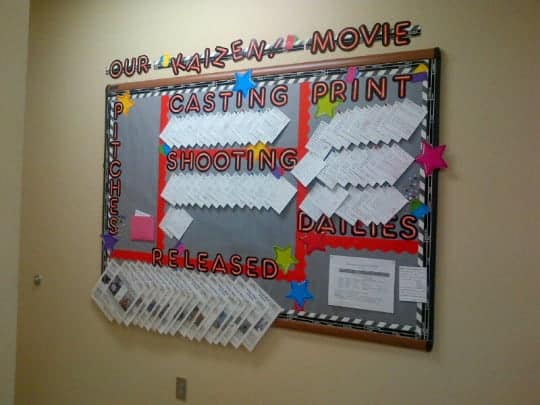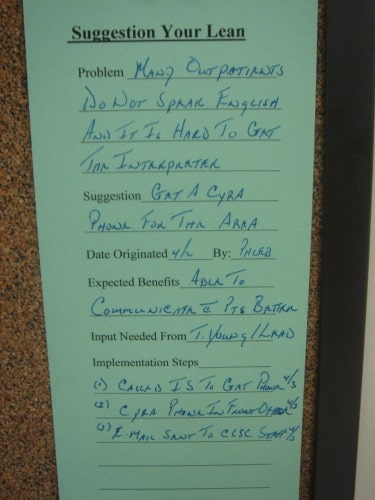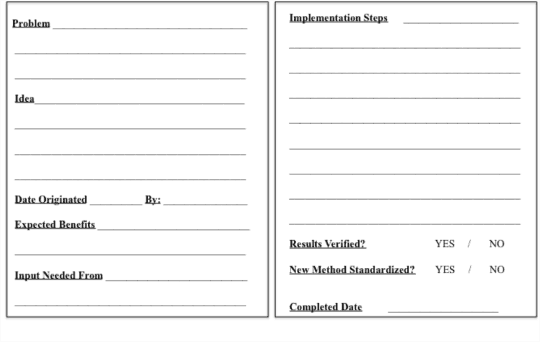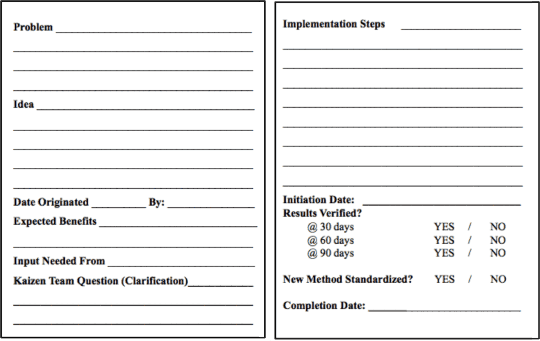When I teach and coach people on the “Kaizen” style of continuous improvement, I emphasize that what I'm teaching them isn't perfect and it's not to be carved in stone. People can continuous improve their continuous improvement process in so many different ways.
For example, I often start people off with a boring, plain “visual idea board.” I invite the group to make the board fun, colorful, and creative (and they often suggest this right away without me having to prompt it). Below is an example of a transformation from boring to colorful to very creative:
The original board:

The more colorful board:

The really creative board (a year after starting):

As you can see, the hospital has gotten creative with the board and the categories. They often change their theme – in this case, a movie theme.
- New Ideas –> Pitches
- To Do –> Casting
- Doing –> Shooting
- Done –> Print Dailies
The “Released” section is there they have posted their “Kaizen Report” (or before-and-after summary) like this example from a different hospital.
The manager in the area says that the creative board is more engaging. The proof is in the amount of Kaizen activity that is taking place in that emergency department.
They have also created a “Kaizen team” that they creatively and enthusiastically call the “Kai-yeah!” team that takes a lead role in evaluating and coordinating improvement activity (while keeping others involved).
After a year of Kaizen activity, momentum has grown and they own their Kaizen approach. It is THEIR approach… and it is spreading throughout the hospital and the broader health system.
The department also “Kaizened” the card that they use to capture and track individual ideas.
They first started with my basic card (that we provide as a free download on our book's website):
One other hospital I worked with recently discovered that it was better to have the backside of the card be flipped upside down. That way, when a card is tacked up to a board, you can read the back by just flipping it up instead of having to take the card down from the board. We have that version available as a PDF download too.
One other hospital I worked with years ago, decided they didn't want to flip cards over at all, so they put all of the card content on a single “A5” sheet of paper (a sheet of letter size paper cut in half). This took up more room on the board, but made everything more visible. I wouldn't be a very good Kaizen consultant (or I'd be a hypocritical one) if I didn't let the team improve the Kaizen process.

Now, I did push back a bit about putting the word “Suggestion” on their card (I normally label this as an “Idea.”). But, they were pretty insistent that they should call it a “Suggestion,” so I said, “Let's try it and see how it works.”
I think the word “suggestion” implies that the improvement needs to be done by somebody else, like a manager or a committee. It brings to mind the things that didn't work with the old suggestion box system… but if leaders have the right mindsets and work together with people, they could make this system work.
Back to the hospital with the movie-themed board. They also tweaked their Idea Card format as follows:
They added a field for the Kaizen Team to write down a clarifying question and response.
On the back of the card, they have built in formal 30, 60, and 90-day checks to see if the new process still works and if they are still getting results. I really like that.
So, they distinguish between the date when the improvement was “initiated” versus when it was deemed to be “completed” (90 days later).
I've also see organizations take the free-form “Expected Benefits” field, turning that into checkboxes that align with organizational goals:
I prefer a free-text field where people have to write out things like “improve patient satisfaction and reduce cost,” because I think it forces people to think it through a bit more instead of checking a box or two.
That said, if you're going to have a Kaizen program (with paper cards or with a technology like KaiNexus, where I am on the management team), it needs to be YOUR approach. You need to own your own workflow and you should certainly feel free to tweak, adjust, and improve every aspect of your continuous improvement approach.
My co-author Joe Swartz talks about this in our upcoming podcast discussion (to be released on Thursday). Joe talks how his organization has tweaked and improved their system over time. For example, they are trying to rely less on contests and promotions to encourage Kaizen activity. They're wanting Kaizen to be a natural and organic process that's prompted by engaged leadership, not prizes and contests.
Kaizen – a little better, every day. And that includes our approach to Kaizen! What are you doing to improve your improvement work?
What do you think? Please scroll down (or click) to post a comment. Or please share the post with your thoughts on LinkedIn – and follow me or connect with me there.
Did you like this post? Make sure you don't miss a post or podcast — Subscribe to get notified about posts via email daily or weekly.
Check out my latest book, The Mistakes That Make Us: Cultivating a Culture of Learning and Innovation:












One could argue that adding colorful wrapping paper to bulletin board is “non-value adding”, but…
if it improves the awareness and therefore the participation and therefore the value, then go for it.
People need to understand that’s its not just about having a process and then expecting everyone to keep it front of mind. You have to ask yourself “what percentage of someone’s day will they spend on this?” Unless it is either a significant chunk or frequent use, then it requires something to get it in front of people. A colorful creative board is one method. A forced topic on a meeting agenda is another. Getting email reminders that there is something to do is another. And, building it into your standard work (unless that needs its own reminder to get down) is yet another.
The point is…out of sight, out of mind.
Hey Jamie-
Yeah, I understand what you’re saying. That’s why the boring, uncreative engineer in me does pretty plain Jane boards as a default.
What I like is that people WANT to make these more creative and visually interesting. Cool. I’ve come to expect it and it almost always happens (as it did today, helping a hospital start with Kaizen in a department). In this case, making it colorful, also served to form the lines between the four columns… so there was some function to the colors.
It doesn’t take that much time and that person has pride in ownership of an improvement (to the board). It doesn’t directly affect patients or customers, but if that person is more jazzed up Kaizen, then I figure they’re more likely to participate in other Kaizens that will improve things for patients, their co-workers, and the hospital in measurable and meaningful ways.
Like you suggest, an eye-catching board isn’t enough. I agree. Leaders making time to work with people Kaizen plays a major role and I certainly help to encourage that too.
Mark